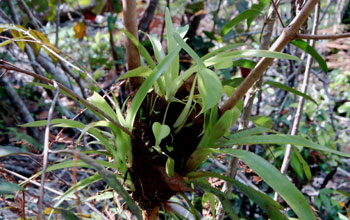Multimedia Gallery
CEIBA Research, Guyana (Image 2)
In an "ant garden." There is a little known, yet facinating, relationship that exists between ants and plants known as an "ant garden." Busy worker ants will assemble a group of tropical epiphytes--nonparasitic plants that are not rooted and therefore grow above ground surface using other plants or objects for support. Approximately 10 percent of all seed plants and ferns fall in this category, as well as many mosses and lichens.
To assemble the "garden," the ants bring seeds from the epiphytes to their nest, and as the seeds germinate and grow, they are nourished by composting detritus--loose material that results from rock disintegration or abrasion--that is brought back to the nests by worker ants. The roots of the growing plants intertwine and become a permant part of the colony's home. The mature plants will provide the colony with fruit pulp and nector.
This image was taken as part of research centered at the CEIBA Biological Center, Inc. in Guyana, by Professor Godfrey Bourne of the department of biology at the University of Missouri-St. Louis. Bourne is currently program director of the Behavioral Systems Cluster, Division of Integrative Organismal Biology at the National Science Foundation.
Bourne is personally involved (both monetarily and with his time) in administrating the CEIBA Biological Center Inc. as a nonprofit research, education and conservation field station in Guyana. Research opportunities for postdoctoral associates, graduate and undergraduate students are available in Guyana on a diversity of organisms.
This research was supported in part by the National Science Foundation. [One of several related images. See next image Here.] (Date of Image: 2004-2006)
Credit: Photo by Godfrey R. Bourne
Images and other media in the National Science Foundation Multimedia Gallery are available for use in print and electronic material by NSF employees, members of the media, university staff, teachers and the general public. All media in the gallery are intended for personal, educational and nonprofit/non-commercial use only.
Images credited to the National Science Foundation, a federal agency, are in the public domain. The images were created by employees of the United States Government as part of their official duties or prepared by contractors as "works for hire" for NSF. You may freely use NSF-credited images and, at your discretion, credit NSF with a "Courtesy: National Science Foundation" notation.
Additional information about general usage can be found in Conditions.
Also Available:
Download the high-resolution JPG version of the image. (1.7 MB)
Use your mouse to right-click (Mac users may need to Ctrl-click) the link above and choose the option that will save the file or target to your computer.



